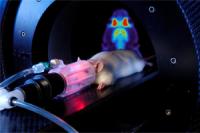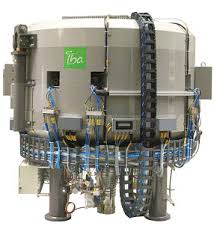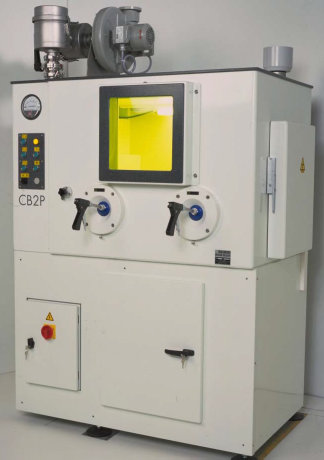ACTIVITIES
The expertise of MIRCen in the domain of PET imaging covers the following strategic axes:
1. The validation of radiotracers in validated animal models of human diseases. |
2. The validation of animal models by PET with validated radiotracers. |
| 3. The evaluation of new therapies with a view to transfer to clinical research. |
The PET platform also works closely with the NMR and histology platforms for the three-dimensional reconstruction of multimodal images (Image Processing platform).

PET imaging system for rodents
EQUIPMENT
The PET platform currently houses:
- Two PET systems are available allowing two PET examinations to be carried out simultaneously for studies in rodents and primates (FOCUS 220, Siemens, Knoxville, TN). These two systems have the following characteristics:
- An axial field of view of 7.6 cm,
- A transaxial field of view of 19 cm,
- A spatial resolution of 1.4 mm,
- A sensitivity of 3.4%
- Two Swisstrace systems to automatically measure the input function of whole blood
- Anesthesia and monitoring equipements for small animals
- A lab dedicated to autoradiographic studies with long half-time isotopes
|
Radiochemistry
ACTIVITIES
The radiochemistry platform allows the radiosynthesis and the development of new radiotracers specific to biological targets involved in a pathological process. Labeling concerns little molecules (molecular weight < 500 Da) and macromolecules (molecular weight > 500 Da) also. The future in house cyclotron will produce the 2 short half-life radioisotopes 11C and 18F (20.4 and 109.8 minutes respectively):
- For [18F]fluorine labeling, nucleophilic reactions based on [18F]fluoride are used.
- For [11C]carbon labeling, [11C]carbon dioxide is the primary precursor; O- and N-methylation reactions (involving [11C]CH3I or [11C]CH3OTf) or carbonylation reactions are mainly used.
Another radioisotope with a longer radioactive half-life will be used latter when the pharmacokinetics of the radiotracer and the biological process under study will require it.
At the end of the radiosynthesis, all radiotracers are analyzed by HPLC in a quality control lab to check their chemistry and radiochemistry purities.
EQUIPMENT
Since the opening of MIRCen, PET tracers have been radiolabeled at the Radiochemistry Laboratory of Frédéric Joliot Hospital, with a biomedical cyclotron and dedicated synthesizers housed in ventilated, shielded areas, according to current regulations. The future new radiochemistry infrastructure will make use of the same facilities.

| 
|
Cyclone 18/18 IBA cyclotron
| Lemer Pax hot cell
|
| |

|
|
Flexlab iphase synthetizer